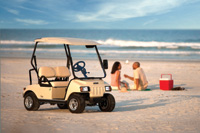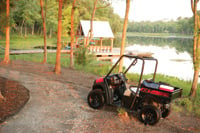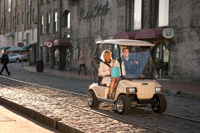 There is no “average” RVer. They range from young couples in pop-up trailers to seniors in motor coaches, from nature lovers who dry camp to luxury lovers who bask in RV resorts, and from sports fans who tailgate to snowbirds who use their coaches as second homes.
There is no “average” RVer. They range from young couples in pop-up trailers to seniors in motor coaches, from nature lovers who dry camp to luxury lovers who bask in RV resorts, and from sports fans who tailgate to snowbirds who use their coaches as second homes.
But many have one thing in common: they like to take a more nimble vehicle along for local transportation. This can be an automobile towed behind a motorhome, but there are other options, including four-wheel vehicles that can fit inside an RV. Mike Gast, vice president of communications for Kampgrounds of America (KOA), said the growing popularity of toy haulers is feeding this trend.
If you’re considering a vehicle of this type, it’s important to find the right fit for your RV lifestyle. William Sandoval, a Club Car engineer and avid RVer, shared his insights on how to do that.
“Don’t start taking test drives until you determine how you’ll use your vehicle, both when RVing and at home,” Sandoval says. Then consider these three categories of small four-wheel vehicles: golf cars, utility vehicles and low speed vehicles (LSVs), a relatively new class of vehicle that can reach speeds of 25 mph and be driven on streets with speed limits of 35 mph or less in almost all states.
Make the Rounds in a Golf Car
Many RVers—especially snowbirds, those who stay in high-end RV resorts and those who live in their RVs year round—opt for golf cars.
Since weight is an issue with RVers, Sandoval advises you to look for a golf car with a lightweight aluminum frame. “Aluminum frames are not only much lighter, they are also strong, rustproof and corrosion resistant, so vehicles built on aluminum frames also last longer,” he says.
Many RVers opt for gasoline-powered golf cars so they won’t have to charge batteries while traveling, others because they travel in mountains and want a more muscular gasoline engine. If you go with gas, look for a vehicle with a powerful name-brand engine and a big gas tank for longer range.
People who own toy haulers, stay in RV resorts or drive coaches with generators may prefer electric vehicles. “Electric vehicles are quiet, and you don’t have to worry about fumes in your RV,” Sandoval says.
Look for an electric vehicle with a powerful drive system with regenerative braking that captures and stores energy lost during stopping. “This extends the miles you can travel on a single charge,” he says.
In either case, you’ll want a vehicle with self-compensating rack-and-pinion steering and independent suspension for superior handling and a smoother ride.
“For rain protection, make sure the canopy has a drainage system that channels water to the ground,” Sandoval says.
If you want to ride with children or another couple, look for a golf car manufacturer that offers a stretch conversion kit that adds two additional forward-facing seats. “This is a better arrangement for socializing than a rear-facing back seat,” Sandoval says.
Into the Woods in a UTV Hunters or trail riders may prefer utility transport vehicles. Unlike all terrain vehicles (ATVs), which a single rider mounts like a motorcycle, four-wheel UTVs carry two to four in automotive-style seats. They also accommodate cargo boxes, gun racks and many other accessories.
Hunters or trail riders may prefer utility transport vehicles. Unlike all terrain vehicles (ATVs), which a single rider mounts like a motorcycle, four-wheel UTVs carry two to four in automotive-style seats. They also accommodate cargo boxes, gun racks and many other accessories.
“We have a lot of hunters who camp at our sites in the fall, because they like to come back to their RV for a hot shower and a good night’s sleep,” Gast says.
Many hunters think they need a gas, diesel or four-wheel drive UTV, but today’s electric and two-wheel drive vehicles also make for a good day in the woods. What’s more, electric models are silent, and don’t create fumes, so they won’t frighten animals or smell up your RV.
Two- or Four-Wheel Drive
“Many 4×4 sales are driven by perception, not reality,” Sandoval says. “If you plan to park alongside the trail and walk into the woods, a small two-wheel drive may be fine. Some of these even fit in the back of a pickup truck.”
If you’ll be crossing creeks, driving in rain or mud, climbing hills or covering rocky terrain, go with a larger vehicle with four-wheel drive.
“But look for an automatic four-wheel drive system that senses the ground it’s on and changes gears automatically. In a traditional 4×4, you can be getting stuck before you even have time to pull levers or push buttons,” Sandoval says.
Explore the Area in an LSV If you use your RV as a home or vacation home, or want a vehicle you can drive out of the park and into the surrounding area, consider an LSV. These small electric cars are street legal in most states on streets with speed limits of 35 mph or less.
If you use your RV as a home or vacation home, or want a vehicle you can drive out of the park and into the surrounding area, consider an LSV. These small electric cars are street legal in most states on streets with speed limits of 35 mph or less.
“We have the infrastructure to charge these and other electric vehicles at all our sites,” says Gast. “And many of our parks, especially our holiday parks, are located in areas where LSVs would be legal.” But check local ordinances.
LSVs are great for shopping, exploring the surrounding area and as second cars. They fit easily into the garage space of a toy hauler.
Unlike golf cars, LSVs are classified as motor vehicles and regulated by the National Highway Transportation Safety Administration. They can be driven only by licensed drivers, and must be registered and insured. Mandatory windshields, turn signals, head and taillights and seat belts help ensure safety.
When shopping for an LSV, consider the range and electric drive system and review the warranty before buying.
“As the technology surrounding electric vehicles evolves, you’ll be seeing even more small four-wheel vehicles at RV parks,” says Gast.
“But do your due diligence before buying,” Sandoval adds. “The quality, performance and comfort of these vehicles varies considerably among manufacturers.”
Betty Sosnin is a public relations consultant whose clients include Club Car, which makes a variety of small vehicles.
WHAT TO LOOK FOR:
Regardless of the type of small four-wheel vehicle you select, experts say it should have these features:
• Built on a lightweight, rustproof aluminum frame.
• Backed by coast-to-coast service, parts and factory-trained mechanics.
• Designed to accommodate a wide range of accessories.
• Equipped with a big gas tank or powerful electric drive system to give you the range you need.
• Made by a manufacturer able to customize the ride, especially if that includes mechanical changes. Mechanical modifications by anyone other than the original manufacturer can affect the vehicle’s warranty or safety.
• Carry a long, strong warranty.

Leave a Reply